This article was published in Scientific American’s former blog network and reflects the views of the author, not necessarily those of Scientific American
Welcome to the third article in the series on trends and tendencies in non-bird maniraptoran evolution (part 1 is here, part 2 is here). In previous articles we looked at the position of maniraptorans within the theropod radiation, and at the main maniraptoran groups. You’ll need to have remembered most of the relevant group names for the following to make sense… though, if you haven’t, I wouldn’t worry about it much, I’m sure it’ll work out.
The trends that emerge. So, with the phylogenetic framework discussed in part 2 in mind, a few very interesting things emerge. Firstly, note that the early members of all the different maniraptoran lineages are small. Early paravians are all similar in size to Archaeopteryx (c 500 g), early oviraptorosaurs like Caudipteryx are small, but not as small (c 5 kg or less), alvarezsaurs are all small too, and early therizinosaurs are small (albeit nowhere near as small as the animals listed so far, ancestral size perhaps being c 40 kg).
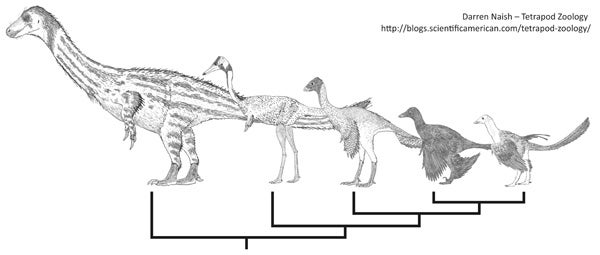
The early members of the various maniraptoran lineages indicate continual reduction in size. Early therizinosaurs (like Falcarius at far left) are bigger than (left to right) early alvarezsaurs and early oviraptorosaurs, both of which are bigger than early dromaeosaurs and early avialans. Illustrations by Darren Naish, from the in-prep textbook (on which follow this link).
On supporting science journalism
If you're enjoying this article, consider supporting our award-winning journalism by subscribing. By purchasing a subscription you are helping to ensure the future of impactful stories about the discoveries and ideas shaping our world today.
When mapped onto a phylogeny, this data (and that pertaining to other theropod groups) indicates a continual, gradual reduction in size, such that the ancestral maniraptoran was smaller than the animals that gave rise to other, nearby coelurosaur groups, and that the common ancestors along the maniraptoran lineage as a whole were gradually shrinking (Lee et al. 2014). For more on this issue, see the article I wrote about it back in 2014.
Life on the ground, life in the trees, or not. Secondly, the phylogenetic pattern described above allows us to make some inferences about the locomotor abilities and habitat preferences of these animals. A very familiar debate concerns whether birds and bird flight originated in arboreal environments or terrestrial ones. Some surprisingly polarised views have been put forward on this view – surprising because, if anything, early avialans and other paravians have features suggesting that they may have been flexible as goes ecomorphology.
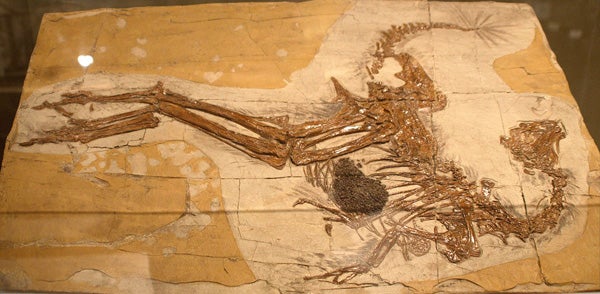
Caudipteryx and similar animals presumably provide key information on the ancestral ecomorphology for non-paravian pennaraptorans. These sorts of dinosaurs do not look at all suited for climbing, and were omnivorous or herbivorous. Photo by Kabacchi, CC BY 2.0.
Rather, the anatomy of early avialans and dromaeosaurs like microraptorines – the curvature of their claws, proportions of their limbs and so on – suggests at least some ability to climb, perch, and leap about among branches, but not to a degree that can be considered inconsistent with a mostly terrestrial way of life (Hopson 2001). I wrote about this issue back in 2012 following the publication of Birn-Jeffery et al. (2012).
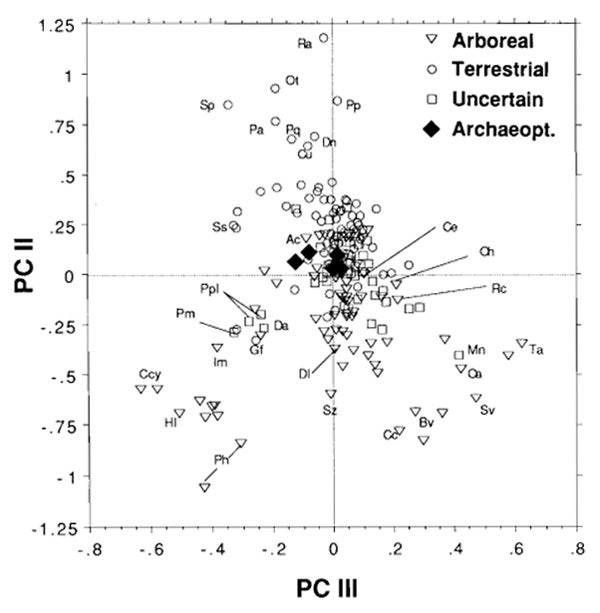
Several studies have looked at the proportions of maniraptoran limb bones (toe bones, hindlimb elements) and correlated them with ecomorphology. This diagram (from Hopson 2001) - showing data from toe bones - shows Archaeopteryx to plot in a mixed zone where terrestrial, arboreal and generalist taxa also occur. It looks likely that the predatory feet of paravians encourage their grouping with arboreal birds. Nevertheless, the general pattern repeatedly observed in early paravians is that they were essentially terrestrial while generalised enough to be capable of some climbing.
Things are different outside of Paraves, however: there’s nothing in the anatomy of oviraptorosaurs, therizinosaurs or alvarezsaurs that looks at all indicative of a climbing ability. Ok, it’s possible that Caudipteryx, Falcarius and so on could have jumped about on sturdy, low-growing, horizontal branches (it’s conceivable that they did this sort of thing when roosting), but this was most likely the limit of their climbing ability*. And alvarezsaurs look about suited for climbing as do emus.
.jpg?w=600)
Alvarezsaurs: in some respects, convergent with ratites (like the emu at right).
* Don’t give me some smug observation about goats: their unusual hooves (which are linked to adaptation to life on rocky ledges and hillsides) are consistent with an ability to hop about in trees and walk on branches. As a caveat to this caveat, there are, of course, other animals where anatomy, truly, is not destiny… (Naish 2014).
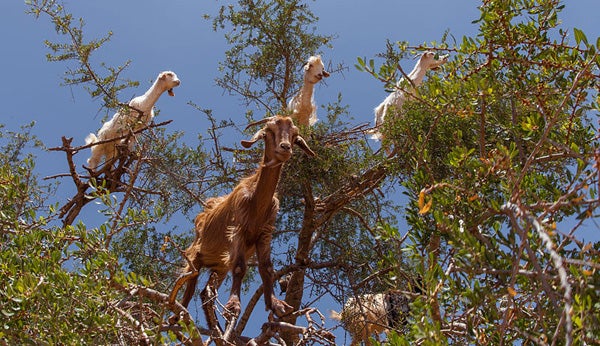
Goats can climb trees.... which actually isn't all that surprising if you know a bit about artiodactyl behaviour and morphology. Photo by Grand Parc, CC BY 2.0.
What this means is that maniraptorans were ancestrally terrestrial, that adaptation to terrestrial walking and running was the typical condition for non-paravians, and that an ability to climb and clamber should be considered an advanced condition that only arose (perhaps independently on two or three occasions) within paravians. Note that those latter groups originated at small size, and were in possession of pennaceous feathers. Ah yes, feathers…
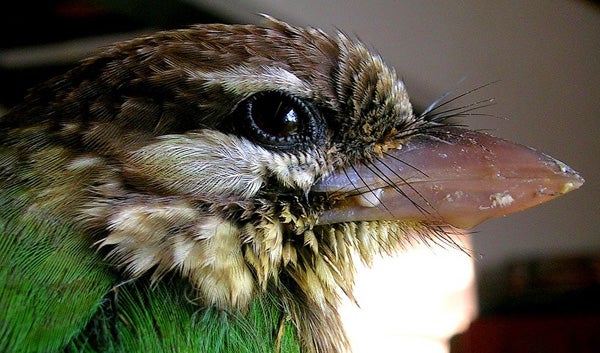
FEATHERS!! .. here on a White-cheeked barbet (Psilopogon viridis). Image by L. Shyamal, CC BY-SA 2.5.
Who has pennaceous feathers, and who doesn’t. Thirdly, there was obviously a point during maniraptoran evolution when pennaceous feathers originated, and then proliferated on the forelimbs and tail such that oviraptorosaurs and paravians really were surprisingly bird-like in the extent and volume of their feathery covering. So far as we can tell, this happened close to the origin of Pennaraptora, the lineages outside this clade possessing filamentous structures alone.
There’s an important caveat I have to discuss here. The recent discovery of long integumentary forelimb structures in ostrich dinosaurs – a group, you’ll recall, that are outside of Maniraptora but fairly closely related to them – has led to the suggestion that big, pennaceous forelimb feathers originated outside of Maniraptora (Zelenitsky et al. 2012). If this is correct, pennaceous forelimb feathers and even wing-like forelimbs would be predicted for the very earliest maniraptorans.
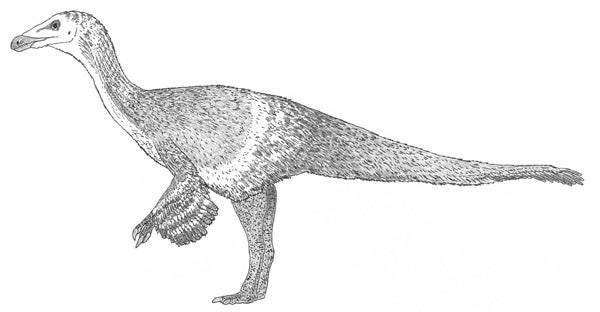
The proposal that ostrich dinosaurs had pennaceous feathers led to several reconstructions like this one (which is by me). I no longer think that this is correct and instead think that we should be depicting these animals with filamentous and quill-like structures only.
However, all I’ll say for now is that the case for pennaceous feathers in ostrich dinosaurs hasn’t yet been made to the satisfaction of many of us in the research community. If you’re wondering what this means exactly… well, we’re not sure, but my thinking is that large filaments of some sort may have been present on the forelimbs of these dinosaurs – an idea already familiar due to our discussion of whatever’s going on in the allosauroid Concavenator (an issue covered here on Tet Zoo back in 2010). Keep this in mind when reconstructing therizinosaurs and other non-pennaraptorans.
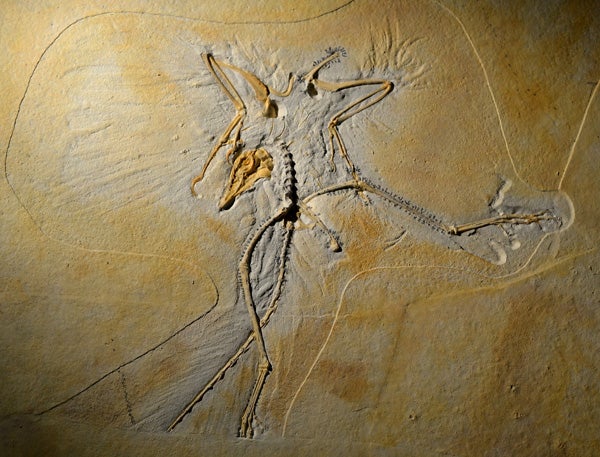
Excellent specimens of Archaeopteryx - this is the Thermopolis specimen - reveal long, pennaceous feathers on the arms, hands, hindlimbs and emerging from both sides of the tail. We now know that essentially the same configuration of feathering was present on pennaraptorans belonging to other lineages too. Image by incidencematrix, CC BY 2.0.
Moving on… why, then, did pennaceous feathers evolve in early pennaraptorans? The conventional idea as goes the origin of pennaceous feathers (and indeed feathers as a whole) is that they evolved among tree-climbers or leapers and provided an aerodynamic advantage of some sort. However, any such claim is more questionable than long thought, not only because the first maniraptorans to possess pennaceous feathers don’t seem to have been using them in connection with a lifestyle involving leaping, gliding, fluttering or flapping, but also because the feathers themselves are not as ‘aerodynamic’ as convention would have it. Even the modern-looking wing feathers of the paravian Archaeopteryx – long said to be asymmetrical and thus indicative of specialisation for flight – are actually not asymmetrical in the same way that flight feathers are. Archaeopteryx – poster-child for the Aerodynamic Origins of Feathers Hypothesis – might have been flightless (I’m referring here to work in prep by Mike Habib, so far only presented at conferences).

Despite what you might often see in artistic reconstructions, the pennaceous feathers of Mesozoic pennaraptorans grew from the whole length of the second finger, as is illustrated in this 1985 diagram of the wing of Archaeopteryx by the late Derek Yalden. A magpie wing is shown at the top. From Yalden (1985).
To restate this another way, the first maniraptorans to possess pennaceous feathers – animals close to the ancestry of oviraptorosaurs and the lineage leading to paravians – are assumed to have been predominantly terrestrial and to lack any features linked to aerial ability (like especially long forelimbs). It thus doesn’t look as if those complex feathers initially evolved within the context of flight, gliding or aerial behaviour of any sort.
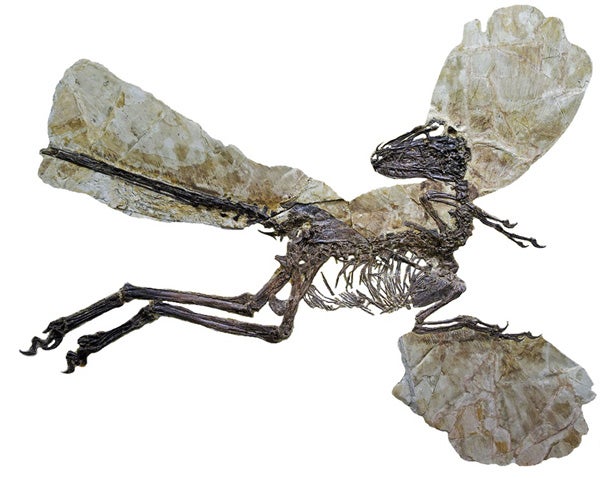
Check out the size of the pennaceous forelimb and tail feathers in the 2-m-long Chinese dromaeosaur Zhenyuanlong (here emphasised by digital removal of surrounding matrix). Image from Lü & Brusatte (2015), CC BY 4.0.
If you’re wondering at this point about wing-assisted incline running (WAIR), the fact that ancestral pennaraptorans lack features that might be associated with rapid forelimb fluttering or with climbing or the ascent of steep surfaces indicates that WAIR was not, I think, operating in early pennaraptorans, and thus not linked to the early evolution of pennaceous feathers. Was WAIR important later on in maniraptoran evolution? Well, that’s something we’ll come back to later on.
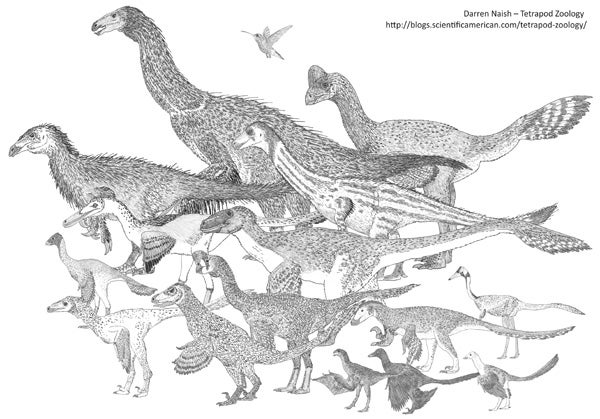
An assortment of maniraptorans -- illustrations from my in-prep textbook (on which click here. Many thanks to those who provide support).
Coming next: feathers and display.
For previous Tet Zoo articles on Mesozoic maniraptorans and related dinosaur groups, see…
Luis Chiappe’s Glorified Dinosaurs: The Origin and Early Evolution of Birds
Did Velociraptor and Archaeopteryx climb trees? Claws and climbing in birds and other dinosaurs
Yi qi Is Neat But Might Not Have Been the Black Screaming Dino-Dragon of Death
Refs - -
Hopson, J. A. 2001. Ecomorphology of avian and nonavian theropod phalangeal proportions: implications for the arboreal versus terrestrial origin of bird flight. In Gauthier, J. & Gall, L. F. (eds) New Perspectives on the Origin and Early Evolution of Birds: Proceedings of the International Symposium in Honor of John H. Ostrom. Peabody Museum of Natural History, Yale University (New Haven), pp. 211-235.
Naish, D. 2014. The fossil record of bird behaviour. Journal of Zoology 292, 268-280.
Yalden, D. 1985. Forelimb function in Archaeopteryx. In Hecht, M. K., Ostrom, J. H., Viohl, G. & Wellnhofer, P. (eds) The Beginnings of Birds – Proceedings of the International Archaeopteryx Conference, Eichstätt 1984, pp. 91-97.
Zelenitsky, D. K., Therrien, F., Erickson, G. M., Debuhr, C. L., Kobayashi, Y., Eberth, D. A. & Hadfield, F. 2012. Feathered non-avian dinosaurs from North America provide insight into wing origins. Science 338, 510-514.